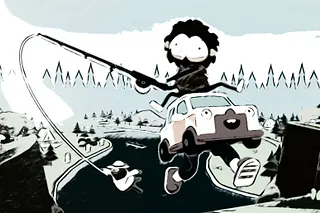
Why You Need to Keep Failing Even When You’re at the Top
Journal 9 Ahmetcan Demirel June 8
When we look at the top games on the charts, the Royal Matches, the Candy Crush Sagas, the Project Makeovers, it’s easy to imagine that their developers must have discovered a secret formula. “It’s all in the numbers”, we think. “They must have the most perfect roadmap with every step masterfully calculated”. But the reality is much messier than that.
In truth, the more successful your game becomes, the more you need to fail in order to sustain and even grow that success. Because early success, while still a tremendous feat, often leans heavily on well-known moves: adopting established best practices, leveraging known market behaviors, following paths already proven by others. You can copy, adapt, and execute. And if you do it better or more efficiently, you can thrive to a certain extent.
However, once you graduate from that initial phase and secure your place among the top competitors, the rules change dramatically. Now, differentiation is mandatory. Standing out is no longer about playing by the book. It’s about writing new chapters.
At this point, you’re often venturing into areas where no clear benchmarks exist. If you want to innovate without completely alienating your existing player base, you need to experiment with features that either no one has tried or that you must adapt creatively to your unique ecosystem. And that’s not easy. In fact, it’s expected that most experiments will fail. Not because the team is lacking in skill, but because at the frontier of innovation, trial and error is the only roadmap.
When you study the best-performing games closely, one thing becomes clear: continuous experimentation, frequent public tests, and visible feature failures are part of the normal operating system. Not a deviation from it.
When Adoption Goes Wrong
Adopting a proven feature sounds like a safer bet than inventing a new one. But the catch is that what works perfectly in one game can completely flop in another. And some features are so universally appealing and straightforward that their adoption feels almost frictionless.
Take the Super Light Ball from Royal Match, for example, a feature we discussed in-depth previously. About two years after its introduction, it became nearly impossible to find a successful Match-3 or Blast game without some version of it. The early adopters, such as Toon Blast, could simply incorporate it without much friction. Even slower movers like Candy Crush Saga eventually rolled it out with a relatively smooth adaptation process, which we will mention in a minute.
But not all features are created equal in terms of complexity and fit. Royal Match themselves offered a perfect cautionary tale recently when they tried to adopt Project Makeover’s win-streak-based extra moves system. On paper, it sounds clean: reward consecutive wins by granting players a few bonus moves. Project Makeover executed it elegantly and made it a meaningful part of their core progression system.

Royal Match took a thematic spin on it and launched Super Duke: A charming dog character who offered three bonus moves for maintaining a win streak of five levels. It wasn’t just a simple mechanical copy, but a carefully integrated, brand-consistent version of the idea. Arguably, it was a way better implementation than its source of inspiration. And yet, Super Duke quietly disappeared after a public test. The feature didn’t stick.
It was probably because even small changes to fundamental game systems, like the number of moves available to complete a level, can have massive second-order effects that aren’t visible during initial design or internal testing. Moves per level aren’t just numbers; they define difficulty pacing, monetization balance, and player emotional arcs. A win-streak system that grants extra moves might shift those dynamics in ways that hurt the game’s carefully tuned core.
Was it a bad idea or was it a bad execution? I don’t think so. It was simply an experiment that, after testing in the wild, did not support the larger ecosystem as intended. Even a market leader with one of the best-performing puzzle games had to acknowledge: not everything simple and proven elsewhere will succeed here.
Sometimes It Doesn’t Pay to Be Unique
When a feature is already working spectacularly elsewhere, sometimes the safest move is to stay close to the original formula. Candy Crush Saga gave us a telling example with their approach to the Super Light Ball. They created a version called Super Charger. Almost a one-to-one adaptation, which they introduced carefully:
- Players needed to complete a set number of levels to unlock it for just 24 hours.
- The unlock requirement was gradually reduced from 10 to 6 to 4 levels over time.
- It was visible only intermittently, minimizing the chance of systemic disruption.
The Super Charger test has been running for months now and seems to have integrated quite successfully into the game. But King didn’t stop there. They also introduced a more original twist called Super Wrapped. An enhancement to their wrapped candy booster (equivalent of bomb or TNT in other puzzles) with a larger area of effect. It was a fresh take, differentiated from anything else in the market, and arguably executed just as cleanly as Super Charger. It was also not tied to any auxiliary condition like a win streak. However, within a few weeks, Super Wrapped vanished.

Two simultaneous tests, two carefully crafted features. The “safe” one worked while the “creative” one failed. The takeaway is critical: being unique doesn’t guarantee success despite differentiation offering a lot of value most of the time. Even with exceptional execution and sound logic, some ideas simply don’t resonate with players or fit the systemic needs of a live game.
This is not a failure of design or ambition. It’s just part of the process when you’re pushing against the boundaries. And if a giant like King, with decades of experience, meticulously structured tests, and enormous player pools, still sees half of their public experiments fail, it’s clear that failure is not just inevitable, it’s integral.
Embracing Failure as a Feature, Not a Flaw
At a glance, failure seems like the last thing a top-performing game should tolerate, let alone expect. But in reality, the most successful games don’t just accept failure, they depend on it.
When you’re operating at scale, the bar for impact is so high that the only ideas worth pursuing are the ones that might not work. If they were guaranteed to succeed, your competitors would already be doing them and your players would already be bored. At that level, real progress comes from finding the one idea out of ten that actually moves the needle, and the only way to get there is to keep testing and discarding the other nine.
And keep in mind: the examples discussed here are only the visible ones. Large, public-facing features that happened to leave traces we can analyze. Behind the scenes, there are countless other experiments running constantly. Tests that change difficulty curves, move reward thresholds, alter drop rates, or modify retention nudges. These micro-level experiments are rarely noticed by players, yet they often drive the biggest gains in engagement, monetization, and long-term retention.
Failure isn’t a signal that something’s broken. It’s a byproduct of asking the right questions. The ones that don’t have obvious answers. That’s why we see world-class teams like Dream and King launch features that vanish just as quickly. It’s not because they lacked clarity. It’s because they had the discipline to test without attachment and the insight to walk away when something didn’t work.
So no matter how high your game climbs, keep failing. Because if you aren’t willing to fail at the top, in both obvious and invisible ways, you won’t stay there for long.







